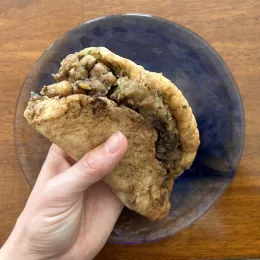For aspiring chefs who dream of creating their own menus, the Institute of Culinary Education's final practical exam can be thrilling — as long as you're prepared for it.
After months of demanding kitchen work, the final two days of ICE's Culinary Arts program consist of market basket challenges where students put forth their own dishes for their Chef-Instructor to evaluate. These assessments test all of the skills students learn throughout the course, from knife work to seasoning, plating and even their ability to keep their stations clean.
While stressful, this was a unique opportunity to be creative using foods and flavors that I enjoy while showcasing the technical skills I learned. My market basket challenge amounted to:
- Day 1: Fabricating a sole fish and then composing a plate of a seared filet, a pan sauce and three other elements showcasing unique cooking techniques (for example: braising, blanching, grilling, pickling, etc.).
- Day 2: Breaking down a chicken and then composing a plate of a seared chicken breast, a pan sauce and three additional components that use culinary techniques different than those in the fish dish.
I wanted to make a plate that I was proud of and something my Chef-Instructor would be impressed by. My classmates all had very different ideas, and I didn’t want my plate to be too simple in comparison. I also didn’t want to overcomplicate elements, because I still had to execute the dish perfectly within two hours and 15 minutes.
To approach this, I reviewed the recipes we had cooked throughout the curriculum and what flavors I liked to eat with each protein. For the fish, I wanted to incorporate seasonal summer ingredients like corn and zucchini and put a twist on the beurre blanc sauce we learned in class. I took the chicken in the opposite direction, designing a plate that was cozier and heartier in color and flavor with roasted potatoes and broccoli rabe.
With my concepts complete, I created an outline to organize and streamline the cooking process. I knew that breaking down proteins took me longer than it took other students, so I had to make sure I didn’t waste any of my remaining time cutting shallots twice or not getting the cauliflower roasting early enough to be turned into a puree later. Writing this down was especially helpful for our practice days, so I could annotate what needed to be adjusted, removed or added.
We had three practice days, during which the Chef-Instructor first demonstrated each fabrication then left us to execute our dishes. This was helpful to get a sense of how long some of my elements took to make and how the flavors worked (or didn’t). I hadn’t considered that the cheesy roasted potato stacks I made might not remove cleanly from the aluminum mold and that I should make extra.
In hindsight, being a chef is all about mise en place — being prepared with a plan, prepped ingredients, tools at the ready, extras of everything and knowing the timing for cooking and plating.
Being a chef is all about mise en place — being prepared with a plan, prepped ingredients, tools at the ready, extras of everything and knowing the timing for cooking and plating.
When I started, I knew exactly what my plan was. I knew the amount of preparation I needed for all my elements and I knew what cooking process to start first to make sure the timing aligned.
I was 100% focused. I didn’t have any extraneous thoughts. I didn’t talk to anyone. I just worked — and worked quickly. I was a machine on auto-mode.
After I presented my dish, I felt a surge of energy, a high, like I could flip a car. It was invigorating (and draining), and it’s something I felt again after working the line at my externship.
Chef and restaurateur Daniel Boulud was on campus that day, and he visited our kitchen to see what we were doing. Here was one of the most famous culinary icons, and here I was, presenting my dish to him. This was a once in a lifetime opportunity and I could barely remember what I made as I handed him the plate. After tasting my dish, he said my roasted garlic and cauliflower puree was too garlicky — but honestly, I didn’t care because I was so starstruck.
After Chef Daniel tasted my dish, my Chef-Instructor tasted it as well and gave me constructive critiques. Composing, preparing and planning these two dishes for the final exam was a huge challenge, but one that ultimately paid off by enhancing my confidence.
Once this final exam was done, I breathed a sigh of relief and headed off to my externship.
Related:What is an Externship?






